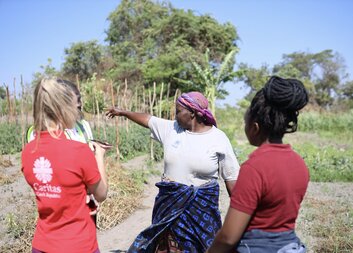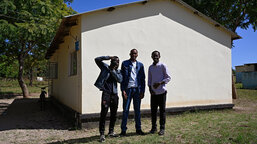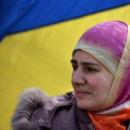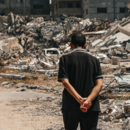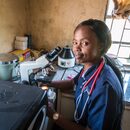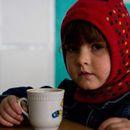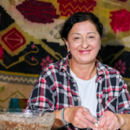The Democratic Republic of the Congo is experiencing one of the worst humanitarian crises today, yet it often remains overlooked by the world. A renewed conflict in the east of the country is having devastating effects on the civilian population. Here, we present five key facts to help you understand the current situation – from the resurgence of fighting and the M23 rebel group to the number of victims and displaced persons, as well as the assistance provided by Caritas Czech Republic to Congolese refugees in Zambia.
1. What is the current situation in the DRC: Renewed conflict and humanitarian impact
After several years of relative calm, armed conflict has once again engulfed the eastern part of the Democratic Republic of the Congo, particularly the provinces of North and South Kivu. The M23 rebel group resumed its offensives at the end of 2021 and gradually took control of large areas in North Kivu province. The fighting escalated at the turn of 2024 and 2025 – by the end of January 2025, M23 rebels had captured the provincial capital of Goma, leading to intense street battles. These clashes resulted in the deaths of approximately 3,000 people, with many more wounded. Fighters even entered the streets of Bukavu, the second-largest city in eastern Congo.
The situation for civilians is critical, with mass displacement, widespread destruction of villages and infrastructure, and limited access to humanitarian aid due to ongoing violence.
The humanitarian impact of the conflict is enormous. Even before the fall of Goma, nearly one million internally displaced Congolese had already been living in its vicinity, having fled previous M23 offensives and surviving in vast makeshift camps.
The latest wave of fighting is increasing these numbers even further – tens of thousands of families are fleeing their homes, either expanding existing camps or seeking refuge in schools, churches, or with relatives. In January alone, more than half a million residents of North Kivu province were forced to leave their homes. The security situation is also deteriorating: humanitarian organisations report cases of looting, sexual violence, and other attacks on civilians in conflict zones.
Overall, the crisis in the DRC is among the most severe in the world and requires international attention.
2. Who is the M23 group, and who supports it?
The escalation is driven by the armed rebel group M23 (March 23 Movement), which emerged in 2012. The name "M23" refers to the peace agreement signed on March 23, 2009 – an agreement between the then-Tutsi militia (CNDP) and the government, which M23 rebels claim was not upheld by the authorities.
During its first rebellion against the Congolese government in 2012, M23 caused mass displacement and took control of Goma, the capital of North Kivu province. By the end of that year, the Congolese army, supported by UN peacekeeping forces, regained control of Goma, forcing hundreds of M23 fighters to flee to neighboring countries. However, the group was never fully dismantled, and by late 2021, it had launched a new insurgency in North Kivu province.
M23 claims to fight for several objectives: it asserts that it seeks to protect minority groups, particularly the Tutsi community in eastern Congo, demands the fulfillment of the 2009 agreements, and highlights the government's failure to ensure security, combat corruption, and provide basic services in the region.
However, M23’s actions contradict its stated goals. The group has committed severe human rights violations, including massacres of civilians, sexual violence, and the forced recruitment of child soldiers.
M23 also seeks to control territories rich in mineral resources, which fuels its conflict with government forces and other armed groups. The North and South Kivu provinces, located near Lake Kivu, contain vast deposits of rare minerals – particularly coltan, gold, and diamonds. Coltan, in particular, is a crucial strategic resource used in the production of small electronics such as mobile phones and computers.
Many indications suggest that M23 is not operating in isolation – it receives support from foreign actors, further complicating the conflict. UN reports indicate that the rebel movement receives military backing from Rwanda, including weapons, ammunition, and reinforcements. Rwanda, however, denies any involvement. There is also evidence of Uganda’s role – UN experts have documented that M23 and Rwandan military units cross through Ugandan territory and that Ugandan military officials maintain contacts with M23 leadership.
The involvement of neighboring countries has heightened regional tensions: the DRC government accuses Rwanda of destabilising eastern Congo, and relations between the two states remain extremely strained. With external support, M23 has strengthened its capabilities, and its ongoing rebellion threatens to escalate into a broader regional conflict.
3. How many people have been affected by the conflict: Victims, displacement, and the need for aid
The renewed conflict in the DRC is taking a heavy toll on civilians. Accurate casualty figures are difficult to determine, but the battles for Goma at the end of January 2025 alone claimed up to 3,000 lives. Reports indicate that as many as 7,000 people may have died since January due to escalating violence.
Civilians are also suffering in other ways – many have lost their homes, livelihoods, and access to essential care. Armed violence is frequently accompanied by massacres and attacks on civilian targets, leading to additional deaths from hunger and disease.
The scale of displacement is enormous. By the end of last year, the DRC had 6.9 million internally displaced persons – people who had fled their homes but remained within the country. This is one of the world’s largest internal displacement crises, and the number of forcibly displaced Congolese continues to rise as fighting persists. In January alone, more than half a million residents of North Kivu province were displaced.
Most refugees live in makeshift camps or with host families, often in dire conditions – lacking adequate food, water, medicine, and sanitation. The overall humanitarian situation is rapidly deteriorating: even before the recent escalation, UN estimates suggested that more than 21 million people in the DRC – about a quarter of the population – required humanitarian assistance.
The crisis in the DRC also has an international dimension, as hundreds of thousands of people are fleeing beyond its borders. Currently, over one million Congolese refugees live outside the country, primarily in neighboring states such as Uganda, Rwanda, Burundi, and Zambia.
These people have often left everything behind to save their lives and now depend on the support of host communities and international organizations. However, finding refuge in neighboring countries is not easy – refugees face uncertainty, poverty, and the challenge of rebuilding their lives from scratch in a foreign environment.
4. Congolese refugees in Zambia: Their numbers and living conditions
One of the countries where Congolese citizens seek refuge is neighboring Zambia. Zambia is a relatively peaceful and stable country that has provided asylum to refugees for decades. Currently, it hosts over 100,000 refugees, the majority of whom come from the Democratic Republic of the Congo.
Zambia has established three major refugee settlements – Meheba, Mayukwayukwa, and the newest, Mantapala, in the north of the country. These camps and settlements are located in remote rural areas, and living conditions for refugees are modest. Most families live in simple mud huts, small brick houses, or makeshift shelters.
While Zambia offers refugees safety from conflict, life in refugee camps or a foreign country remains difficult. Many refugees arrive with minimal belongings and are entirely dependent on state and humanitarian aid. Due to government restrictions, refugees have limited job opportunities, and earning a living is particularly challenging in remote settlements compared to major cities.
Most refugees try to sustain themselves through small-scale farming or by starting micro-businesses such as food stalls or tailoring.
5. How Caritas Czech Republic supports refugees in Zambia: Education and self-sufficiency
Caritas Czech Republic has been working in Zambia since 2013, focusing on supporting refugees and local communities to improve their living conditions and stand on their own feet in their new country.
For example, in cooperation with UNHCR, we provide scholarships to refugee students so they can continue their university studies and gain qualifications for future employment.
This support has made it possible for young people to study who would otherwise not have been able to afford tuition fees - such as a young doctor Sigiro, who fled with her family from the DRC to Zambia and was only able to complete her medical degree thanks to a DAFI scholarship.
In addition to education, Caritas Czech Republic also focuses on the livelihood and economic self-sufficiency of refugees. In the refugee settlements, we help people start small businesses and acquire job skills so that they can support themselves in their new country through their own work.
With our support, small tailoring workshops have been set up, for example, or a community computer centre to teach digital skills. "What I love most about my job is that we are helping people and improving our own skills," says Fis, a refugee from Congo and one of the centre's founders.
Caritas Czech Republic also focuses on sustainable agriculture in remote refugee settlements. It organises training for refugees in modern farming methods, provides seeds and the necessary tools, and helps farmers adapt their farms to climate change.
These activities give refugees hope for a better future - enabling them to stand on their own feet, integrate into society and earn a decent living even in conditions far from home.

